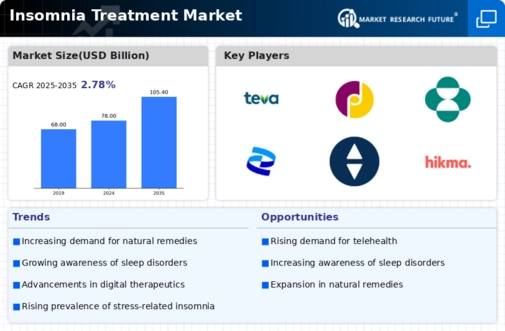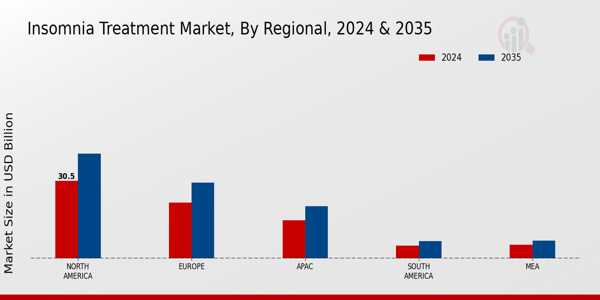Growing Prevalence of Insomnia
The rising incidence of insomnia is a primary driver for the Insomnia Treatment Market. Recent studies indicate that approximately 30 percent of adults experience insomnia symptoms, with around 10 percent suffering from chronic insomnia. This increasing prevalence is attributed to various factors, including heightened stress levels, lifestyle changes, and the pervasive use of technology. As more individuals seek effective solutions for sleep disturbances, the demand for insomnia treatments, including pharmacological and non-pharmacological options, is likely to surge. Consequently, this trend is expected to propel the growth of the Insomnia Treatment Market, as healthcare providers and pharmaceutical companies respond to the urgent need for innovative therapies.
Increased Focus on Mental Health
The increasing focus on mental health is emerging as a crucial driver for the Insomnia Treatment Market. Mental health conditions, such as anxiety and depression, are closely linked to sleep disorders, including insomnia. As society becomes more attuned to the importance of mental well-being, there is a corresponding rise in the demand for treatments that address both mental health and sleep issues. This trend is reflected in the growing number of integrated treatment programs that combine cognitive behavioral therapy for insomnia with mental health support. The Insomnia Treatment Market is likely to expand as more individuals seek comprehensive solutions that address the interconnectedness of sleep and mental health.
Rising Awareness of Sleep Disorders
There is a growing awareness of sleep disorders, which is becoming a significant driver for the Insomnia Treatment Market. Educational campaigns and initiatives by health organizations are informing the public about the importance of sleep health and the potential consequences of untreated insomnia. This heightened awareness is leading to more individuals seeking professional help for their sleep issues. As a result, healthcare systems are increasingly prioritizing sleep medicine, which is likely to enhance the demand for insomnia treatments. The Insomnia Treatment Market stands to benefit from this trend, as more patients are diagnosed and treated for insomnia, thereby expanding the market.
Advancements in Pharmaceutical Research
Innovations in pharmaceutical research are significantly influencing the Insomnia Treatment Market. The development of new sleep medications, including dual-action drugs that target multiple pathways in the brain, is enhancing treatment efficacy. Recent data suggests that the insomnia drug market is projected to reach USD 4.5 billion by 2026, driven by these advancements. Furthermore, the introduction of non-benzodiazepine sleep aids, which offer fewer side effects, is likely to attract a broader patient base. As research continues to unveil novel therapeutic targets, the Insomnia Treatment Market is poised for substantial growth, with an increasing array of options available to healthcare providers and patients alike.
Integration of Technology in Treatment Solutions
The integration of technology into treatment solutions is transforming the Insomnia Treatment Market. Digital health tools, such as mobile applications and wearable devices, are being utilized to monitor sleep patterns and provide personalized recommendations. This technological advancement not only empowers patients to take control of their sleep health but also facilitates better communication between patients and healthcare providers. The market for sleep technology is expected to grow significantly, with estimates suggesting it could reach USD 2 billion by 2025. As technology continues to evolve, the Insomnia Treatment Market is likely to see an influx of innovative solutions that cater to the diverse needs of patients.


















Leave a Comment